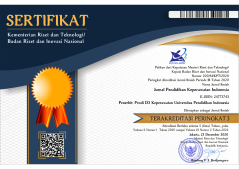Penerapan Video Pembelajaran dapat Meningkatkan Keterampilan Klinis dalam Pendidikan Keperawatan: A Literature Review
Abstract
ABSTRAK
Perkembangan teknologi informasi dan komunikasi dapat memberikan dampak positif dalam dunia pendidikan. Pendidikan keperawatan saat ini dituntut harus memiliki standar metode pembelajaran yang tepat supaya dapat diterima untuk peningkatan keterampilan klinis, pencapaian tujuan pembelajaran, merangsang minat belajar secara mandiri, dan membantu tenaga pengajar dalam mencapai efektifitas pembelajaran. Literature review ini bertujuan untuk melihat penerapan video pembelajaran dapat meningkatkan keterampilan klinis mahasiswa dalam pendidikan keperawatan. Metode yang digunakan dengan menganalisis beberapa tulisan artikel full text berbahasa inggris dengan rentang 2008-2018. Database yang digunakan adalah PubMed, Google Scholar, dan ScienceDirect, dengan kata kunci “learning video in nursing”, “teaching and learning for nursing”, “clinical skills in nursing”, dan “nurse education”. Artikel diseleksi menggunakan systematic review dengan PRISMA (Preferred Reporting Items for Systematic Reviews and Meta-analyses) dan didapatkan sebanyak 25 artikel. Literature review menemukan 4 aspek penting penerapan video pembelajaran dapat meningkatkan keterampilan klinis mahasiswa diantaranya (1) meningkatkan efektifitas pembelajaran; (2) lebih efisien dibandingkan metode konvensional; (3) pola penerapan video yang tepat dapat menigkatkan keterampilan klinis mahasiswa; dan (4) kualitas atau durasi video yang baik akan mempengaruhi pemahaman dan ketrampilan. Pembahasan literature review ini berkaitan dengan video pembelajaran lebih efektif dalam mempresentasikan materi ajar dan mentranformasi ilmu kepada mahasiswa. Selain itu, penerapan video pembelajaran juga berdampak positif dalam meningkatnya aktivitas dan motivasi belajar mahasiswa terutama dalam peningkatan keterampilan klinis dalam pendidikan keperawatan.
ABSTRACT
The development of information technology and communication can give a positive effect on education word. The learning for nursing today is required must have the right standard of learning method so it can be received for improving the student's clinical skill, the achievement of learning goals, stimulating interest in learning by self effectivity. The literature review has a purpose to see the learning video application, can improve the student's clinical skill in teaching for nursing. The method is used by analyzing some articles full text in English by range 2008-2018. The database is used namely PubMed, Google Scholar and ScienceDirect. By keynote "learning video in nursing, teaching and learning too nursing, clinical skill of nursing and nurse education. The articles which found is selected by using systematic review with PRISMA (Preferred Reporting Item of Systematic Reviews and Meta-analyses) and has got 25 articles. Literature review which finds 4 important aspects in application learning video, can improve the student's clinical skill, among of them (1) improve the learning effectivity, (2) more efficiency compared with conventional method, (3) the pattern of the right video application can improve the clinical skill of students and (4) the quality or duration of the good video. The discussion of literature review according to learning video more effective in presenting the teaching material and transform knowledge into the student. Beside of that the application learning video has positive effects in improving activity and studying motivation for the student especially in improving clinical skill in learning for nursing.
Keywords
Full Text:
PDFReferences
Akhlaghi, N. M., Khalilak, Z., Vatanpour, M., Moshari, A., Ghaffari, S., & Namazikhah, M. S. (2017). Students’ Knowledge Comprehension after Implementation of Live Conventional Demonstration, Video Teaching and Video- Assisted Instruction Methods in Endodontic Practice. Iriania Endodontic Journal, 12(2), 201–204.
Alfes, C. M. (2008). Setting the Stage for Clinical Simulation : Developing an Introductory Video. Clinical Simulation in Nursing, 4(3), 65–67.
Arguel, A., & Jamet, E. (2009). Computers in Human Behavior Using video and static pictures to improve learning of procedural contents. Computers in Human Behavior, 25(2), 354–359.
Barratt, J. (2010). Nurse Education in Practice A focus group study of the use of video-recorded simulated objective structured clinical examinations in nurse practitioner education. Nurse Education in Practice, 10(3), 170–175.
Bond, C. S. (2009). Nurse Education Today Nurses , computers and pre-registration education. Nurse Education Today, 29(7), 731–734.
Cardoso, A. F., Moreli, L., Braga, F. T. M. M., Vasques, C. I., Santos, C. B., & Carvalho, E. C. (2012). Nurse Education Today Effect of a video on developing skills in undergraduate nursing students for the management of totally implantable central venous access ports. Nurse Education Today, 32(6), 709–713.
Clifton, A., & Mann, C. (2011). Nurse Education Today Can YouTube enhance student nurse learning ? Nurse Education in Practice, 31(4), 311–313.
Duncan, I., Yarwood-ross, L., & Haigh, C. (2013). Nurse Education Today YouTube as a source of clinical skills education. Nurse Education Today, 33(12), 1576–1580.
Hansen, M. M. (2017). Are nursing students ’ clinical skills competency and self-confidence levels improved via video iPods ? A randomized controlled pilot study. Nursing Education and Practice, 1(1), 32–41.
Hibbert, E. J., Lambert, T., Carter, J. N., Learoyd, D. L., Twigg, S., & Clarke, S. (2013). A randomized controlled pilot trial comparing the impact of access to clinical endocrinology video demonstrations with access to usual revision resources on medical student performance of clinical endocrinology skills. BMC Medical Education, 13, 1–10.
Holland, A., Smith, F., Mccrossan, G., Adamson, E., Watt, S., & Penny, K. (2013). Nurse Education Today Online video in clinical skills education of oral medication administration for undergraduate student nurses : A mixed methods , prospective cohort study. Nurse Education in Practice, 33(6), 663–670.
Homer, B. D., Plass, J. L., & Blake, L. (2008). The effects of video on cognitive load and social presence in multimedia-learning. Computers in Human Behavior, 24, 786–797.
Johnson, N., List-ivankovic, J., Eboh, W. O., Ireland, J., Adams, D., Mowatt, E., & Martindale, S. (2010). Nurse Education in Practice Research and evidence based practice : Using a blended approach to teaching and learning in undergraduate nurse education. Nurse Education in Practice, 10(1), 43–47.
Kelly, M., Lyng, C., Mcgrath, M., & Cannon, G. (2009). A multi-method study to determine the effectiveness of , and student attitudes to , online instructional videos for teaching clinical nursing skills. Nurse Education Today, 29(3), 292–300.
Kingsley, K., Galbraith, G. M., Herring, M., Stowers, E., Stewart, T., & Kingsley, K. V. (2011). Why not just Google it ? An assessment of information literacy skills in a biomedical science curriculum. BMC Medical Education, 11, 1–8.
May, Y. (2010). Video instructions as support for beyond classroom learning. Procedia -Social and Behavioral Sciences, 9, 1313–1318.
Mcallister, M., Levett-jones, T., Downer, T., Harrison, P., Harvey, T., Reid-searl, K., … Calleja, P. (2013). Nurse Education in Practice Snapshots of simulation : Creative strategies used by Australian educators to enhance simulation learning experiences for nursing students. Nurse Education in Practice, 13(6), 567–572.
Moazami, F., Bahrampour, E., Azar, M. R., Jahedi, F., & Moattari, M. (2014). Comparing two methods of education ( virtual versus traditional ) on learning of Iranian dental students : a post-test only design study. BMC Medical Education, 14, 1–5.
Nikopoulou-smyrni, P., & Nikopoulos, C. (2010). Evaluating the impact of video-based versus traditional lectures on student learning. Educational Research, 1(8), 304–311.
Pereira, J., Echeazarra, L., Sanz-santamaría, S., & Gutiérrez, J. (2014). Computers in Human Behavior Student-generated online videos to develop cross-curricular and curricular competencies in Nursing Studies. Computers in Human Behavior, 31, 580–590.
Selwyn, N. (2014). Distrusting educational technology: Critical questions for changing times. (1 ed.). Abingdon Oxon United Kingdom: Routledge.
Selwyn, N., & Stirling, E. (2016). Social media and education … now the dust has settled. Learning, Media and Technology ISSN:, 41(1), 1–5.
Sowan, A. K., & Idhail, J. A. (2014). Evaluation of an interactive web-based nursing course with streaming videos for medication administration skills. International Journal of Medical Informatics.
Thilakumara, I. P., Jayasinghe, R. M., Rasnayaka, S. K., Jayasinghe, V. P., & Abeysundara, S. (2018). Effectiveness of Procedural Video Versus Live Demonstrations in Teaching Laboratory Techniques to Dental Students. Journal of Dental Education, 82(8), 898–904.
Viswasom, A. A., & Jobby, A. (2017). Effectiveness of Video Demonstration over Conventional Methods in Teaching Osteology in Anatomy. Journal of Clinical and Diagnostic Research, 11(2), 9–11.
DOI: https://doi.org/10.17509/jpki.v5i1.15128
Refbacks
- There are currently no refbacks.
Jurnal Pendidikan Keperawatan Indonesia(JPKI) published by Indonesia University of Education. JPKI is licensed under a Creative Commons Attribution-ShareAlike 4.0 International License.
Office :
Nursing Department. FPOK UPI.
229, Dr. Setiabudhi Street. Bandung 40154
West Java , Indonesia
E-mail : jpki@upi.edu

_.png)
_.png)
_.png)











